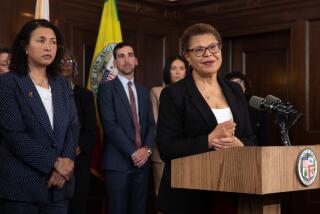Detroit bankruptcy plan cuts pensions, payments to creditors

Detroit hopes to emerge from bankruptcy this year in part by significantly cutting city workers’ pensions and payments to bondholders, according to a blueprint filed Friday to restructure the city’s $18-billion debt.
Detroit is to invest $1.5 billion over a decade to provide basic services, attract new residents and businesses, reduce crime and demolish blighted properties, according to a statement explaining the plan for the largest municipal bankruptcy in U.S. history.
“The plan contemplates the city’s emergence from Chapter 9 this year and represents a crucial step toward the city’s rehabilitation and recovery from a decades-long downward spiral,” the statement said.
The plan treats various classes of creditors differently, which could cause tensions among retirees and current city employees.
It proposes reducing benefits to retired police and fire beneficiaries by 10%. It freezes the accrued pension of current police and fire employees, and then reduces that pension by 10%.
But other city employees and retirees, who hold claims through the general retirement system, could see pensions reduced by around 34%. The city will give additional benefits to those pension holders most in need, the plan says.
In an effort to resolve the bankruptcy quickly, the city said it would reduce the pension payments by less than proposed if pension holders “enter into a timely settlement with the city and state of Michigan.”
The city said “a variety of practices that contributed considerably to the underfunding of the pension plans,” singling out the general retirement system plan, which covers 5,600 active workers and 12,000 retirees.
The city says pension plans are underfunded by $3.5 billion, though unions dispute this number.
“There is still much work in front of us to continue the recovery from a decades-long spiral,” city Emergency Manager Kevyn Orr said in a statement. “We must move swiftly to emerge from bankruptcy so that the financial distress harming the city can end.”
Michigan Gov. Rick Snyder also praised the plan and the work of Orr, whom he appointed.
“Detroit’s comeback is underway,” he said in a statement.
The union representing state and city employees was quick to criticize the big cuts proposed in the plan.
“The proposed plan of adjustment is a gut punch to Detroit city workers and retirees. The plan essentially eliminates healthcare benefits for retirees and drastically cuts earned pension benefits. Retires cannot survive these huge cuts to the pensions they earned. The plan is unfair and unacceptable,” said Al Garrett, the president of AFSCME Council 25.
There are still many steps that must be taken before the plan is approved.
First, U.S. Bankruptcy Judge Steven Rhodes must approve that the disclosure statement is adequate and presents enough information to creditors, said Andrew Gottfried, a partner in the bankruptcy and restructuring practice of the law firm Morgan Lewis.
Then, ballots will go out to creditors, who have the opportunity to vote for or against the plan. At least one class of impaired creditors must vote in favor of the plan for it to go forward, he said.
Some bondholders might object to the fact that they are getting less money than the pensioners, said George South, a partner at DLA Piper in New York. According to the disclosure plan, bondholders will get 20 cents on the dollar, less than either of the pension funds. Bondholders could object, saying that Judge Rhodes already declared that all creditors were equal under bankruptcy law.
“They could argue that you can’t distribute more to one set of creditors that are equal in priority to another set of creditors under the bankruptcy code,” he said.
The plan also takes into account a proposed settlement that uses money from foundations and the state of Michigan to save the Detroit Institute of Arts from having to sell off artwork, and contributes to the pension plans. That may be another issue going forward; some creditors may object to the idea that the city can use money to pay one group of creditors but not another, South said.
ALSO:
Guantanamo Bay detainee pleads guilty in 2002 tanker bombing
Oregon joins the list: State won’t defend gay marriage ban
NTSB weighs role of fatigue, pilot error in Alabama UPS plane crash
More to Read
Start your day right
Sign up for Essential California for news, features and recommendations from the L.A. Times and beyond in your inbox six days a week.
You may occasionally receive promotional content from the Los Angeles Times.







